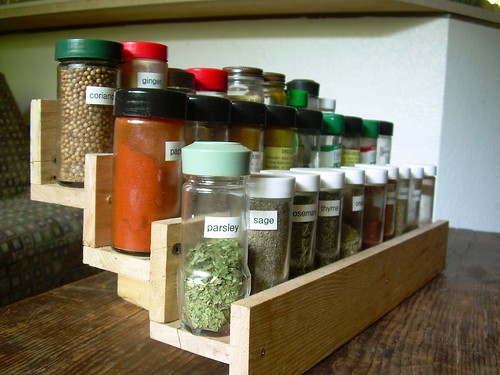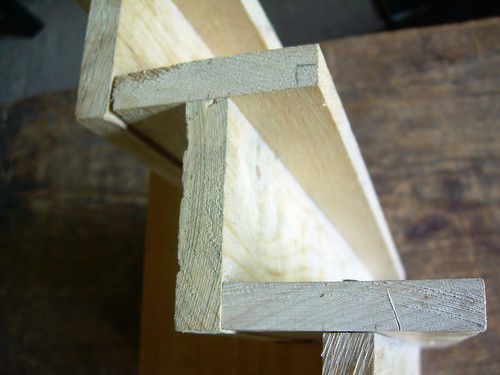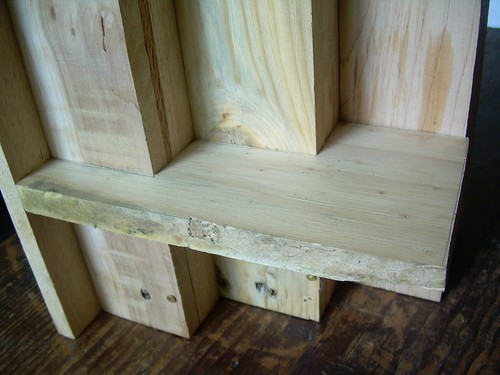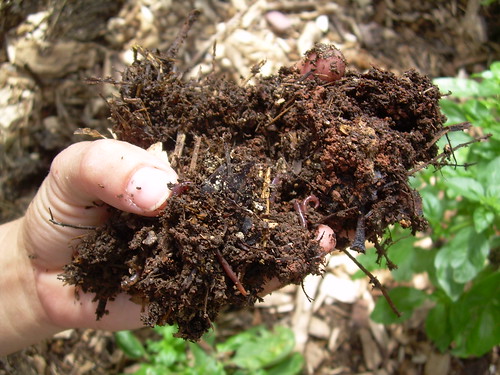 I made this spice rack out of reclaimed pallet wood, as part of the OPENworkshop put on in Summer 2007 by OPENSOURCE Art in Champaign-Urbana, Illinois. I realized that I never put a picture of the final product on the OPENworkshop blog, so I decided to take some pictures and write up a little about how I made this simple spice rack.
I made this spice rack out of reclaimed pallet wood, as part of the OPENworkshop put on in Summer 2007 by OPENSOURCE Art in Champaign-Urbana, Illinois. I realized that I never put a picture of the final product on the OPENworkshop blog, so I decided to take some pictures and write up a little about how I made this simple spice rack.The rack was designed to fit spice jars up to 2" in diameter, and will fit 30 of these jars. There is lots of space underneath the stairs for storing bulk spice bags and other oddments.
First, we stripped the crossboards off of a bunch of trash-pile pallets. We developed a pretty good method using a circular saw and a pry-bar. Details of the method are described in this post on the OPENworkshop blog. Basically, you saw all the cross-boards in the center so they are easier to pry off. After prying the boards off, the next step is removing the nails from all of the boards using a hammer--hammering from behind and then prying from the front. The nails leave behind cool holes and discoloration patterns that add some character to your finished product.
Next, we planed all of the wood smooth with the electric planer that was generously lent to us, along with many of the other tools, for the OPENworkshop. The electric planer is a really nice tool when working with reclaimed wood. You could do the same with a hand plane, but I imagine it would take a lot longer.
Different pallets will yield different board lengths and thicknesses. There were a good number of pieces that were around 20" long, 3.5" wide, and 0.5+" thick (they must have been 1x4's originally), so I decided to use these for the spice rack. Using a table saw, I ripped seven of the pieces so that they were 2.5" wide. Using a miter saw, I cut them all down to 18" long. I used the planer again to get them all down to the uniform thickness of 0.5".
Then I made three 'T' shapes, screwed the three 'T's together, and then added a back. Then I traced the shape of these stair steps onto a miscellaneous pallet board (at least 4" x 7.5") and cut out two of these supports with a jigsaw. Screw the stairs to the two supports and you're done.

 You can tell that I am not an experienced woodworker. I bought brass screws that were more decorative than anything else--the recess stripped incredibly easily.
You can tell that I am not an experienced woodworker. I bought brass screws that were more decorative than anything else--the recess stripped incredibly easily.I've thought about adding some side rails to keep jars from falling off the side, but I haven't really found them necessary and I like the more minimal look. I've also thought about staining or applying some sort of sealant to protect the wood from the liquid dangers of the kitchen, but I'm afraid anything I do will cover up the wood grain or make the finish too shiny, so I've just left it and it has been fine. More photos of the spice rack are on flickr.
You really can make a lot from reclaimed wood. Check out Louis's diagrams showing his system for converting pallet wood and drywall scraps into a modular shelving system or lamps. Mike also made an incredible Illinois shelf.







